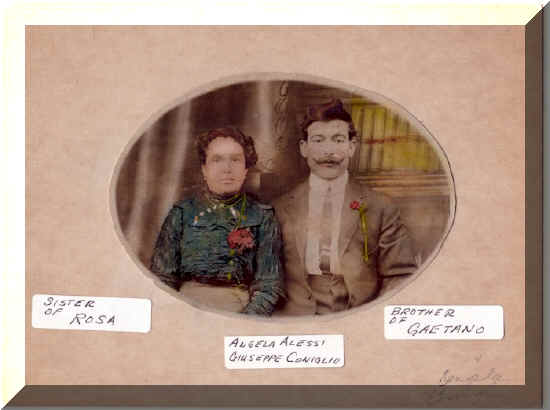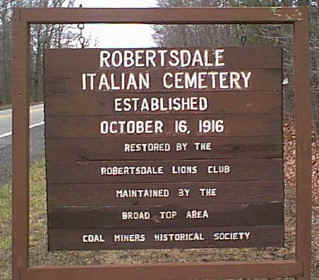Gaetano
spent time in Robertsdale and in
Pittston, Pennsylvania, where he was a coal miner. Gaetano's wife Rosa and year-old son Gaetano (Guy) joined him in
1914 in Pittston, in eastern Pennsylvania, before Gaetano took them to Robertsdale. Giuseppe
and Angela returned to the Coniglio family home at No. 10 Via Migliore in
Serradifalco sometime before 1920, and Angela passed away shortly after
that. Giuseppee never returned to America. He remarried, and
fathered ten children by his second wife, Anna Fazio. Gaetano
and Rosa had three sons (Leonardo, Raimondo, and Felice) in Robertsdale, and
after about 1920, moved on to Buffalo.
Many immigrants from Serradifalco
followed similar paths: Serradifalco to Robertsdale; back and forth between Robertsdale
and Pittston; and ultimately to Buffalo. The rolls of Sicilian residents of
Robertsdale must have looked like a Serradifalco directory: Coniglio, Alessi, Latona,
Asarese, Giumento, Tabone, Territo, Calabrese, Butera, Ali, Turco, Lonobile; and many of
them were relatives or close friends.
Chuck
Dickey has sent us information that his relatives from
the Ali (also Alli) family followed the same route. Below are photos of some of his
family. Chuck also told me he had visited Robertsdale, and he provided us with
information and photos about the Italian Cemetery there. The 1918 flu epidemic,
cited in one photo, may have been the cause of Angela Alessi Coniglio's
illness and subsequent death.
The cemetery sign also
mentions "casualties resulting from acts of violence ... during the 1920s."
This is apparently a reference to coal miner strikes. A search of records of
the last names of current residents of the Robertsdale and Huntingdon County area shows
there are few or none that are Italian. Why did the hundreds of Sicilian families
who lived in Robertsdale leave no descendants there? Did most die of the 1918 flu
epidemic, or the "acts of violence", or did they leave en masse in the 1920s,
searching for a better place?
The 1890's through the
1920's were not only the height of Italian immigration to America, they were the volatile
peak years of coal mining in Western Pennsylvania. The Sicilians were brought in to
a former rural agricultural region, where locals saw their farmland disposessed by coal
mines. Often immigrants were used as ignorant pawns of the mining companies to
be "strikebusters": unorganized miners hired to discourage and impede the
unionization of mine workers. The Sicilians, though, were strong union supporters
and hard workers.
During the same period, the
Ku Klux Klan was almost as active in
Pennsylvania as it was in the South, and the
KKK intimidated, threatened, and even killed
those they disagreed with. Often, earlier immigrants from other
nations, fearing the loss of their jobs to "newer" immigrants, were duped
into joining the Klan.
Don Numer, now of Lebanon,
Pennsylvania, tells the story of his Welsh grandfather, who was convinced by
the Klan that the Sicilians were 'sent by the Pope' to take his job.
He joined the Klan, but when his wife found out three days later, that was
the end of his Klan membership, and the end of his peaked hood and cloak.
Appropriately, she burned
them! Don's mother tells him 'the
families were never proud of it and you didn't speak about any of your
family being Klansmen.....it was the family's dirty little secret'.
But the Klan
did persecute many mainland European immigrants and Roman Catholics. Our ancestors
were both, so it was no wonder that after Felice (Phil) was born in
1920, Gaetano and Rosa moved to Buffalo, as did numerous other friends and relatives who
had gone to Robertsdale from Serradifalco. |





